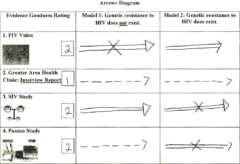Epistemic scaffolds support students as they learn to engage in more sophisticated reasoning. In general, epistemic processes are processes that people use to produce knowledge, understanding, models, arguments, and other valued cognitive products. Our epistemic scaffolds are aimed at supporting these processes as students create and evaluate scientific models. Below we describe several forms of epistemic scaffolds that the PRACCIS team and teachers have found to be effective.
The scaffold to the right is used in one of our lessons, Sam Spade (you can find the complete lesson under “Sam Spade” in the Classroom Resources section.) This lesson introduces students to one of our scaffold, the Model-Evidence Link Matrix. Students learn to draw arrows of different types to show whether evidence supports, strongly supports, contradicts, strongly contradicts, or is irrelevant to two different models. They notice that these diagrams get messy as more evidence is added, which motivates the move to recording arrows in a matrix, which you will see below in the MEL Matrix section.
Epistemic Criteria
In PRACCIS, epistemic criteria are shared, public standards that can be used to judge the quality of models, evidence, arguments, and so on.

MEL Matrices
A central PRACCIS scaffold is the MEL Matrix, which encourage students to systematically weigh and evaluate all the evidence as they develop or decide among models.

Argumentation (Reasoning) Stems
We have used what "argumentation" or "reasoning" stems to facilitate students’ argumentation.

Rubrics for Assessing Arguments
Teachers work with students to develop rubrics for evaluating written argumentation.


